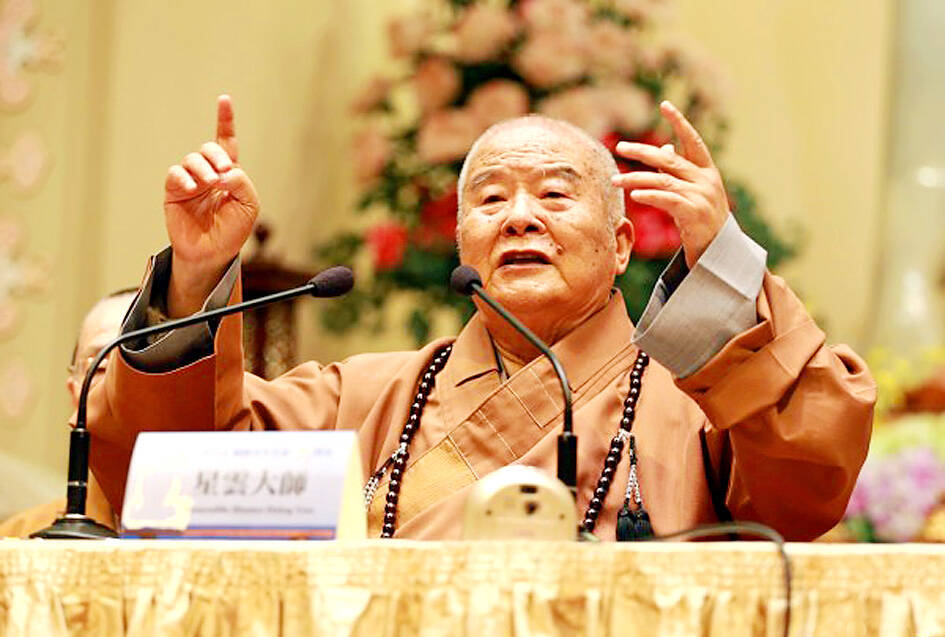Buddhist Master Hsing Yun (星雲法師), founder of the Kaohsiung-based Buddhist organization Fo Guang Shan, died on Sunday at the age of 95.
Fo Guang Shan yesterday confirmed in a statement that Hsing Yun had passed away peacefully at 5pm the previous evening.
A memorial service is to be held at Fo Guang Shan’s Cloud Dwelling Building at 9am on Monday next week.

Photo: Chen Chia-yi, Taipei Times
Hsing Yun, born as Lee Kuo-shen (李國深) in 1927 to a poor family in China’s Jiangsu Province, became interested in Buddhism at age 12 after visiting Nanjing’s Qixia Temple while on a trip to the city with his mother in an unsuccessful effort to find his father.
After taking his religious vows, he graduated from Jiaoshan Buddhist Seminary in 1947. Two years later, he moved to Taiwan, where he taught and was editor-in-chief of the Buddhist publication Humanity Magazine.
In 1967, Hsing Yun founded Fo Guang Shan in Kaohsiung as a monastery with the purpose of promoting “the principles of humanistic Buddhism and foster[ing] peace and harmony among all peoples of the world.”
Fo Guang Shan gradually expanded into education, charity and media. It also founded more than 300 temples worldwide, as well as Buddhist seminaries, libraries and publishing companies.
Beginning in 1991, Hsing Yun established Fo Guang University and Nanhua University in Taiwan, University of the West in the US, Nan Tien Institute in Australia and Guang Ming College in the Philippines.
Since 2015, the five institutions have offered cross-enrollment and exchange programs as part of the Fo Guang Shan University Consortium.
In the past few decades, Hsing Yun also became increasingly involved in China, where he donated funds for the construction of temples and libraries, ran educational and cultural programs, and promoted cross-strait exchanges.
After suffering strokes in 2011 and 2016, Hsing Yun’s health deteriorated and he began making fewer public appearances.
He officially stepped down as director of Fo Guang Shan in 1985, but remained involved in its operations. The organization has been led by Hsin Bao (心保) since 2013.
President Tsai Ing-wen (蔡英文) and Premier Chen Chien-jen (陳建仁) yesterday offered their condolences following Hsing Yun’s death, while expressing respect for his legacy of charity and compassion.

US climber Alex Honnold is to attempt to scale Taipei 101 without a rope and harness in a live Netflix special on Jan. 24, the streaming platform announced on Wednesday. Accounting for the time difference, the two-hour broadcast of Honnold’s climb, called Skyscraper Live, is to air on Jan. 23 in the US, Netflix said in a statement. Honnold, 40, was the first person ever to free solo climb the 900m El Capitan rock formation in Yosemite National Park — a feat that was recorded and later made into the 2018 documentary film Free Solo. Netflix previewed Skyscraper Live in October, after videos

Starting on Jan. 1, YouBike riders must have insurance to use the service, and a six-month trial of NT$5 coupons under certain conditions would be implemented to balance bike shortages, a joint statement from transportation departments across Taipei, New Taipei City and Taoyuan announced yesterday. The rental bike system operator said that coupons would be offered to riders to rent bikes from full stations, for riders who take out an electric-assisted bike from a full station, and for riders who return a bike to an empty station. All riders with YouBike accounts are automatically eligible for the program, and each membership account

NUMBERS IMBALANCE: More than 4 million Taiwanese have visited China this year, while only about half a million Chinese have visited here Beijing has yet to respond to Taiwan’s requests for negotiation over matters related to the recovery of cross-strait tourism, the Tourism Administration said yesterday. Taiwan’s tourism authority issued the statement after Chinese-language daily the China Times reported yesterday that the government’s policy of banning group tours to China does not stop Taiwanese from visiting the country. As of October, more than 4.2 million had traveled to China this year, exceeding last year. Beijing estimated the number of Taiwanese tourists in China could reach 4.5 million this year. By contrast, only 500,000 Chinese tourists are expected in Taiwan, the report said. The report

Temperatures are forecast to drop steadily as a continental cold air mass moves across Taiwan, with some areas also likely to see heavy rainfall, the Central Weather Administration (CWA) said. From today through early tomorrow, a cold air mass would keep temperatures low across central and northern Taiwan, and the eastern half of Taiwan proper, with isolated brief showers forecast along Keelung’s north coast, Taipei and New Taipei City’s mountainous areas and eastern Taiwan, it said. Lows of 11°C to 15°C are forecast in central and northern Taiwan, Yilan County, and the outlying Kinmen and Lienchiang (Matsu) counties, and 14°C to 17°C